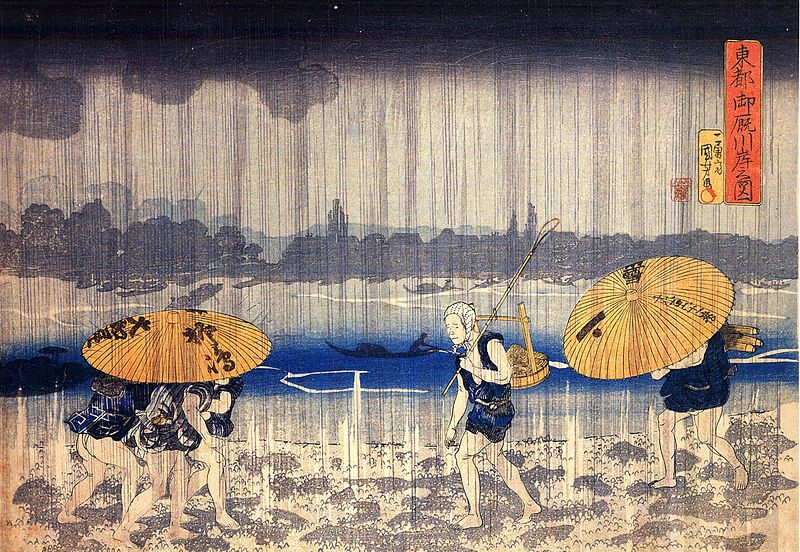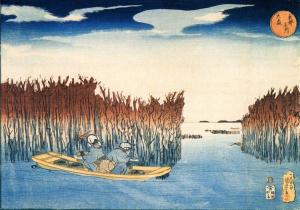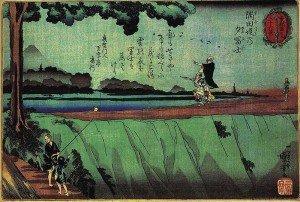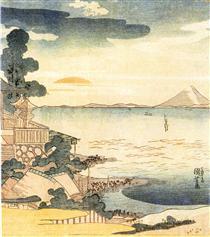Japanese Landscapes by Kuniyoshi
Lee Jay Walker
Modern Tokyo Times

Utagawa Kuniyoshi is among the crème de la crème of ukiyo-e artists because his artwork remains powerful in modern times. Kuniyoshi, just like other famous Japanese artists like Ando Hiroshige and Katsushika Hokusai, was very diverse. This is because the window of a new Japan was on its way and based on the mass creativity of the floating world during the late Edo period.
This article is based on tranquil art pieces by Kuniyoshi because often he is remembered for other artistic themes – therefore, this is the other side of this intriguing artist. However, just like life, these artistic glimpses into Kuniyoshi are misleading based on his natural persona – and other different art themes that meant so much to him. Nevertheless, given the amount of art that Kuniyoshi produced then a more tranquil based article provides an unusual glimpse.

Also, human nature is complex and the outside persona and internal reality are often very different. Therefore, by providing a glimpse into the natural aspect of Kuniyoshi’s art, I hope to relate this with the calm before the storm in a later article.
Kuniyoshi was born in 1798 and died in 1861. This reality means that he belonged to a world of continuity during the early period of his life. However, near the end of his life, it was abundantly clear that changes were underway and this resulted in the Meiji Restoration of 1868. This reality meant that Kuniyoshi could feel the growing influence of external forces that were impacting on Japan alongside internal convulsions.

The art pieces in this article represent the tranquility of Japan before the storm that would erupt and alter the entire region. Likewise, these art pieces don’t represent the storm within Kuniyoshi’s artwork. Therefore, both are false mirages within grains of truth. After all, individuals in all societies often look back to the past with tainted realities, irrespective if childhood memories, the old world and so forth. Kuniyoshi on a whole focused on a broad theme of artistic subjects, for example, landscapes, shunga, ladies, humor, kabuki, surimono, satire, history and other areas. Not surprisingly, this reality means that Kuniyoshi leaves a rich legacy based on a very broad spectrum of themes because his images of warriors and legends are truly imaginative.
It remains to be known if Kuniyoshi would have focused so heavily on warriors and legends if it weren’t for the Tenpo reforms of the 1840s. These reforms infringed on sexual areas related to shunga and erotic areas related to kabuki whereby the mirage was in its entirety. On top of this, historical depictions were also under scrutiny, therefore, anything deemed political became under the microscope. Therefore, his popular satire of shogun Tokugawa Ieyoshi – and others – led to an official reprimand and sadly some prints were confiscated.

It is known that Kuniyoshi was influenced by Katsukawa Shuntei (1770-1820) in the area of warrior prints – but not in other areas of his art. The early period for Kuniyoshi was not easy because it wasn’t until 1827 that he made a major breakthrough. This applies to The 108 Heroes of the Popular Suikoden All Told.
The art pieces in this article depict a natural and cultural aspect of Japan. For example, The Shore of the Sumida River shows the power of nature and the reality of everyday life. The only individual face on view is in a natural state because he looks worn out and battling against the elements. However, the Mt. Fuji from Sumida shows a breathtaking landscape whereby two people are in awe of the stunning beauty on show. Also, another individual is walking blissfully alone in this stunning art piece. The image also shows you a child who is enjoying life with his mother and playing. Therefore, unlike the older individuals, the child is in a dream world because of the energy of childhood. Meanwhile, the other image, Pilgrims in the Waterfall, depicts the unity of faith and nature. Of course, Buddhism was extremely powerful in this period in Japan but the indigenous faith of Shinto is “the real heart of Japan” in the realm of spirituality and culture. This applies to the power of ancestors, the spirit world, nature, and humanity, all co-existing in the real world and the mysterious underworld.

The serenity and spirituality of his art can be felt deeply in the Pilgrims in the Waterfall. On top of this, the stunning image connects humanity with nature but in a natural and simplistic way that appeals to the heart. Therefore, no religious building is needed because the pilgrimage is interwoven with the power of nature and clearly this relates to the inner beauty of Shintoism.
Therefore, the art images of Kuniyoshi in this article are focused on only one side of his artwork because his art was very diverse. Also, despite political constraints, it is clear that he didn’t remain placid.
http://www.kuniyoshiproject.com/
Modern Tokyo News is part of the Modern Tokyo Times group
DONATIONS to SUPPORT MODERN TOKYO TIMES – please pay PayPal and DONATE to sawakoart@gmail.com
http://moderntokyotimes.com Modern Tokyo Times – International News and Japan News
http://sawandjay.com Modern Tokyo Times – Fashion
https://moderntokyonews.com Modern Tokyo News – Tokyo News and International News
http://global-security-news.com Global Security News – Geopolitics and Terrorism
PLEASE JOIN ON TWITTER
https://twitter.com/MTT_News Modern Tokyo Times
PLEASE JOIN ON FACEBOOK
https://www.facebook.com/moderntokyotimes
Some Japanese art and cultural articles are republished based on the need to inform our growing international readership about the unique traits of Japan.
